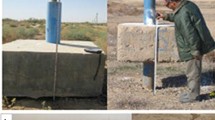Abstract
In order to study the degree of influence and control mechanism to groundwater flow field caused by land creation engineering in the hilly and gully area of the Loess Plateau, based on the geological and engineering conditions of the first stage project of Yan’an new district in China, numerical simulation of groundwater flow is carried out by the Feflow and GIS technologies. From the simulation, punning measure relatively reduces infiltration recharge and artificial gravel drain increases groundwater seepage. The basic characteristics of groundwater flow field is controlled by the old and new topographies in the whole study area, and artificial gravel drain plays an auxiliary role in accelerating groundwater drawdown upstream and promotes groundwater rise downstream. According to differences of groundwater level and declining percentages of hydraulic gradient in the main and secondary gullies, dewatering of artificial gravel drain in the secondary gully is more effective than that in the main gully, which will yet play an important role in the future. The study results will make contributions to understand groundwater response to land creation engineering and will be beneficial to take necessary measures to prevent collapse of loess and failure of building foundation in the hilly and gully area of the Loess Plateau.











Similar content being viewed by others
References
Ashraf A, Ahmad Z (2008) Regional groundwater flow modelling of upper Chaj doab of Indus Basin, Pakistan using finite element model (Feflow) and geoinformatics. Geophys J Int 173(1):17–24
Bresciani E, Davy P, Dreuzy JR (2014) Is the Dupuit assumption suitable for predicting the groundwater seepage area in hillslopes? Water Resour Res 50:2394–2406
Fallah-Mehdipour E, Bozorg HO, Mariño MA (2013) Prediction and simulation of monthly groundwater levels by genetic programming. J Hydro-environ Res 7:253–260
Huang F, Wang GH, Yang YY, Wang CB (2014) Overexploitation status of groundwater and induced geological hazards in China. Nat Hazards 73:727–741
Li PY, Qian H, JH W (2014) Accelerate research on land creation. Nature 510:29–31
Liebel HT, Huber K, Frengstad BS, Ramstad RK, Brattli B (2012) Thermal response testing of a fractured hard rock aquifer with and without induced groundwater flow. B Eng Geol Environ 71:435–445
Piao JL, Kim SB (2012) A correlation analysis tool between Jeju island groundwater level and rainfall. Procedia Environ Sci 12:878–884
Sarwar A, Eggers H (2006) Development of a conjunctive use model to evaluate alternative management options for surface and groundwater resources. Hydrogeol J 14:1676–1687
Sefelnasr A, Gossel W, Wycisk P (2014) Three-dimensional groundwater flow modeling approach for the groundwater management options for the Dakhla oasis, Western Desert, Egypt. Environ Earth Sci 72:1227–1241
Shehata WM, Amin AA (1997) Geotechnical hazards associated with desert environment. Nat Hazards 16:81–95
Sun AY (2013) Predicting groundwater level changes using GRACE data. Water Resour Res 49:5900–5912
Sun DY, Zhao CY, Wei H, Peng DM (2011) Simulation of the relationship between land use and groundwater level in Tailan River basin, Xinjiang, China. Quatern Int 244:254–263
XIGMR (2012) Hydrogeology survey report of the first stage project of Yan’an new district. Scientific research report, Xi’an, Shanxi, China
Zhang SL (2014) Groundwater simulation of the hydrogeological impact on the removing and filling in the loess hilly-gully region. Dissertation, Hefei University of Technology, Anhui, China
Acknowledgments
This work is financially supported by the National Natural Science Foundation of China (no. 41372244) and the Fundamental Research Funds for the Central Universities (no. JZ2016HGBZ0802). We would also like to express our sincere gratitude to the editor and the reviewers for their valuable contributions to this paper.
Author information
Authors and Affiliations
Corresponding author
Rights and permissions
About this article
Cite this article
Yin, X., Chen, L., He, J. et al. Characteristics of groundwater flow field after land creation engineering in the hilly and gully area of the Loess Plateau. Arab J Geosci 9, 646 (2016). https://doi.org/10.1007/s12517-016-2672-7
Received:
Accepted:
Published:
DOI: https://doi.org/10.1007/s12517-016-2672-7




